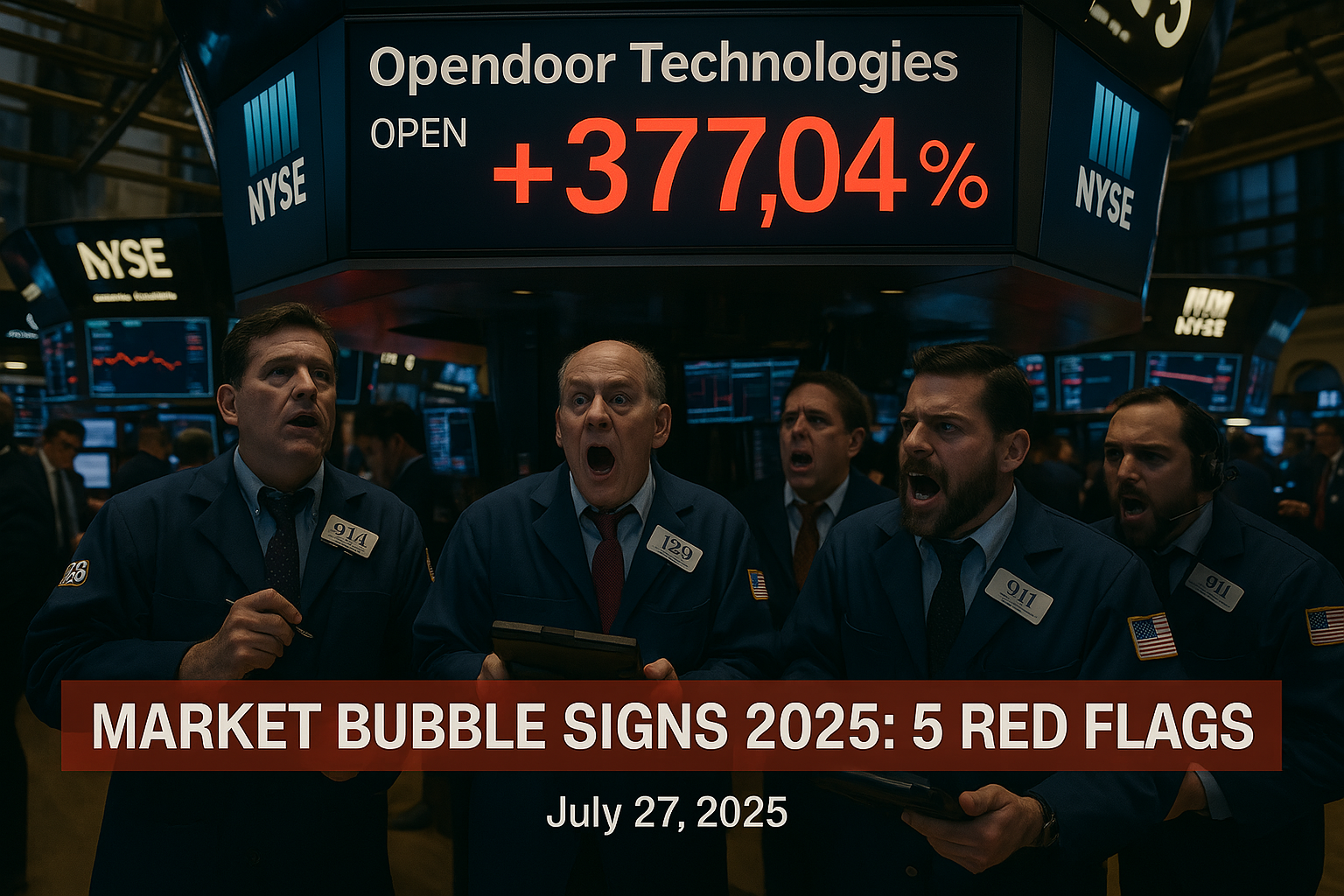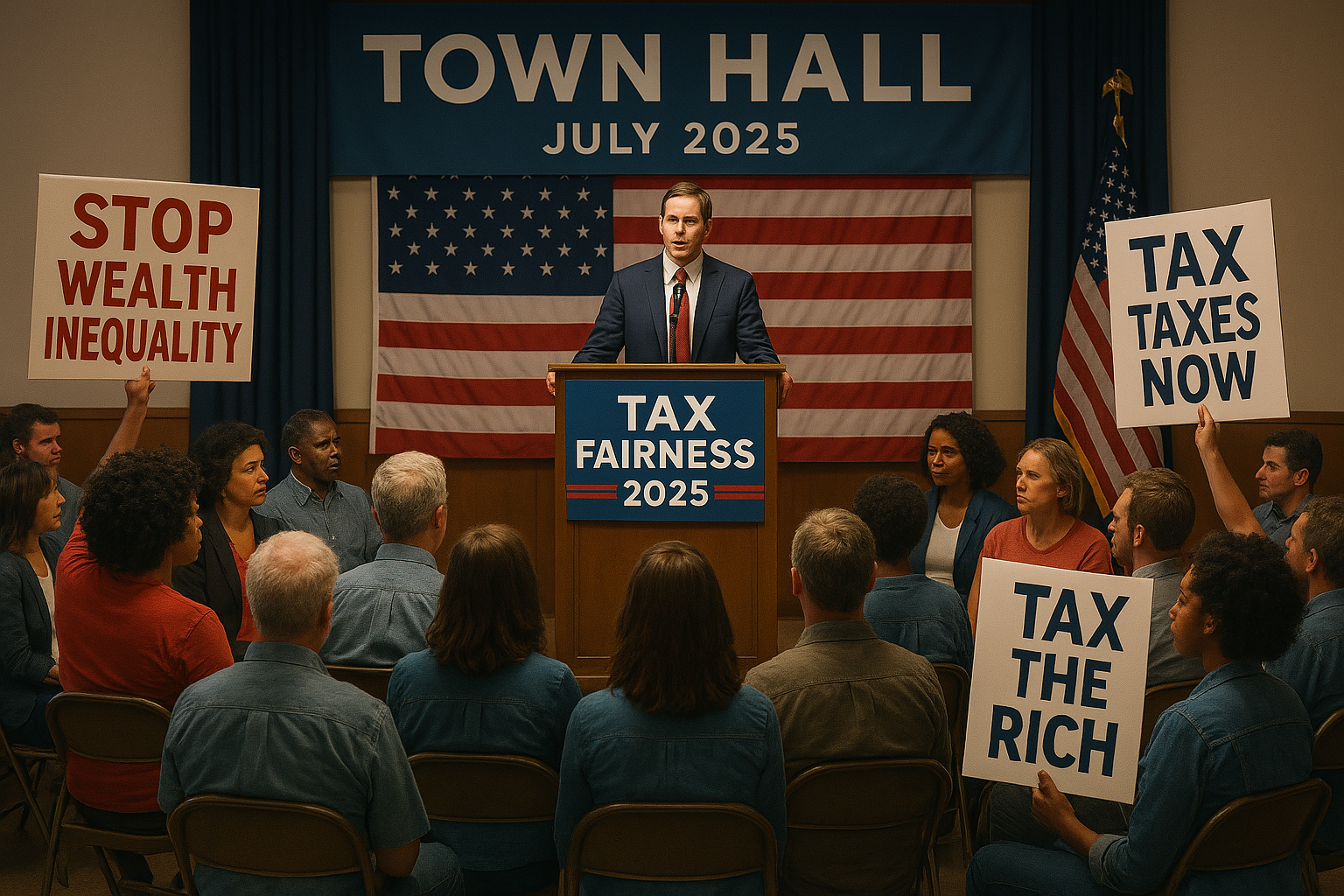Market Bubble Signs 2025: Five Red Flags Investors Must Watch

In July 2025, the U.S. stock market is soaring, with the S&P 500 up 23% year-to-date and the Nasdaq 100 hitting a 60-day streak without dipping below its 20-day moving average, per BTIG data. But beneath the euphoria, warning bells are ringing. The share price of Opendoor Technologies, an online house flipper, skyrocketed 377% in a month despite a stagnant housing market, while Kohl’s, a struggling retailer, surged as a top gainer on July 22. These market bubble signs 2025, as highlighted by the Wall Street Journal on July 27, signal a surge in speculative trades and stretched valuations that could spell trouble. Are investors riding a wave of irrational exuberance, or is this sustainable growth? This article dives into five key indicators of a potential market bubble, backed by data, expert insights, and strategies to safeguard your investments.
Five Signs of a Market Bubble in 2025
Drawing from the Wall Street Journal and industry analyses, here are the five critical signs investors are tracking, with context and implications:
1. Soaring Valuations Detached from Fundamentals
The S&P 500 trades at 26 times forward earnings, 44% above its historical average of 18, per Axios. Mega-cap tech stocks, like Nvidia (40x earnings) and the Magnificent Seven, drive this surge, contributing 58% of the S&P 500’s two-year return, per S&P Dow Jones Indices. Yet, only 6 of the 33 Russell 3000 stocks that tripled since April’s market low reported profits, according to Bespoke Investment Group. Example: Opendoor Technologies, trading at $2.54 after a 377% monthly spike, lacks profitability in a stalled housing market, signaling speculative bets over fundamentals. Implication: High price-to-earnings (P/E) ratios, far exceeding historical norms, suggest prices are driven by hype, not earnings, reminiscent of the 1999 dot-com bubble when tech stocks outpaced GDP.
2. Speculative Frenzy in Volatile Stocks
High-beta stocks, with betas above 1, are surging, with J.P. Morgan noting a “crowding” from the 25th to 100th percentile in three months. The ARK Innovation ETF (ARKK), a proxy for unprofitable tech, climbed 36% year-to-date, per LiveMint. Meme stocks (up 44%), Bitcoin-linked firms (78%), and quantum computing shares (69%) rallied in Q2, per Bloomberg’s Equity Euphoria Indicator, which hit double digits for the first time since February 2025. Example: Kohl’s, down 70% since 2022, spiked on July 22 due to real-estate sale rumors, despite ongoing losses. Implication: Speculative trades, fueled by FOMO, echo the 2021 meme stock frenzy, risking sharp corrections when sentiment shifts.
3. Narrow Market Leadership
Market breadth is shrinking, with the S&P 500’s gains driven by a handful of tech giants, per UBS strategist Andrew Garthwaite. The Russell 2000, representing small-cap stocks, lags significantly, with only 20% of S&P 500 stocks hitting new highs since February, per UBS. Example: The Magnificent Seven (Alphabet, Amazon, Apple, Meta, Microsoft, Nvidia, Tesla) accounted for over half the S&P 500’s 2024 gains, per Bespoke Investment Group. Implication: A concentrated rally, like the Nifty 50 in the 1970s, signals vulnerability, as a stumble by leaders like Nvidia could trigger broader market declines.
4. Retail Investor Euphoria
Retail investors are flooding markets, driven by social media hype and “this time it’s different” narratives, per Bankrate. X posts, like @StockGuru2025, tout 25% CAGR for unprofitable stocks, while @CryptoBoom claims Bitcoin’s $3.8 trillion market cap heralds a new era. Example: GoPro and Krispy Kreme, unprofitable firms, notched double-digit weekly gains, per LiveMint. Implication: When novices chase trends, as seen in the dot-com bubble, it often marks a bubble’s late stage, with retail investors most exposed to losses.
5. Policy and Economic Uncertainty
Trump’s proposed 25% tariffs on imports, announced for February 2025, have already cut General Motors’ Q2 earnings by $1.1 billion, per J.P. Morgan. Inflation remains “sticky” at 3% core PCE, per B2Broker’s John Murillo, with the Fed holding rates at 4.25–4.5%. Example: Avis and Aeva Technologies, both unprofitable, surged despite tariff risks impacting auto and tech sectors. Implication: Policy shocks, like tariffs or rate hikes, could pop a bubble if consumer spending, 70% of U.S. GDP, falters, per Moody’s Analytics.
Historical Context and Risks
These signs mirror past bubbles:
- Dot-Com Bubble (1999–2000): Tech stocks, like Cisco at 200x earnings, drove the Nasdaq up 700% before a 75% crash, per Axios.
- Housing Bubble (2006–2008): Subprime lending and FOMO inflated home prices, leading to a 50% market drop, per Investopedia.
- 2021 Meme Stock Frenzy: GameStop’s 1,500% surge, driven by retail hype, collapsed by 80%, per Forbes.
UBS notes six of eight bubble preconditions exist, including retail participation and a “new paradigm” narrative around AI, per a December 2024 report. Economist Harry Dent predicts an 86% S&P 500 crash, though his view is an outlier, per Business Insider. Mark Zandi of Moody’s Analytics warns a market drop could erode consumer spending, risking economic damage, given stocks’ role in driving wealth effects.
Strategies to Protect Your Portfolio
Investors can navigate these risks with disciplined strategies:
- Diversify Across Assets: Reduce exposure to high-beta tech stocks by allocating to defensive sectors like utilities (up 15% in 2025, per U.S. Bank) or non-correlated assets like gold, which has a negative correlation to equities, per Preserve Gold. Action: Rebalance to include SPDR Gold Shares (GLD) or consumer staples ETFs like XLP.
- Focus on Fundamentals: Prioritize companies with strong cash flows and low P/E ratios, like value stocks in industrials, per Sam Yocum’s advice to the Wall Street Journal. Action: Screen for stocks with P/E below 15 and positive earnings, using tools like Finviz.
- Monitor Market Breadth: Track breadth indicators, like the percentage of S&P 500 stocks above their 50-day moving average, via Bloomberg Terminal. Action: Reduce holdings if fewer than 40% of stocks are advancing, signaling a concentrated rally.
- Limit Speculative Bets: Cap high-beta investments at 5–10% of your portfolio, per Forbes. Action: Trim positions in ARKK or meme stocks if they exceed this threshold.
- Prepare for Volatility: Hedge with put options or increase cash holdings (10–20%) to capitalize on corrections, per U.S. Bank’s Eric Freedman. Action: Set stop-loss orders at 10% below current prices for volatile holdings.
Expert Insights
- Callie Cox, Ritholtz Wealth Management: “The rise in speculative trades isn’t unhealthy yet, but it’s a warning sign when unprofitable stocks lead,” per LiveMint.
- Dubravko Lakos-Bujas, J.P. Morgan: “High-beta crowding is unsustainable, implying rising complacency,” per biztoc.com.
- Howard Marks, Oaktree Capital: “Investors shouldn’t ignore today’s high valuations; a sharp correction is possible,” per CNBC.
- Andrew Garthwaite, UBS: “Six of eight bubble preconditions exist, but a 15–20% rally is possible before a bust,” per Preserve Gold.
Challenges Ahead
The market faces multiple headwinds:
- Tariff Impact: A 25% tariff could raise consumer prices, squeezing spending and corporate earnings, per J.P. Morgan.
- Inflation Risks: Sticky inflation may force Fed rate hikes, increasing borrowing costs and pressuring valuations, per B2Broker.
- AI Hype: Overreliance on AI-driven stocks like Nvidia risks a sector-wide correction if growth disappoints, per Goldman Sachs’ Peter Oppenheimer.
- Retail Vulnerability: Novice investors, lured by social media, face significant losses if a bubble bursts, per Bankrate.
Conclusion
The market bubble signs 2025—soaring valuations, speculative frenzies, narrow leadership, retail euphoria, and policy uncertainty—signal a market teetering on the edge. While the S&P 500’s 23% gain reflects robust growth, parallels to the dot-com and housing bubbles urge caution. Investors can protect portfolios by diversifying, focusing on fundamentals, and hedging against volatility. As Wall Street watches these red flags, the question remains: will 2025 bring another historic rally or a painful correction? Share your strategies below and stay informed on market trends.










